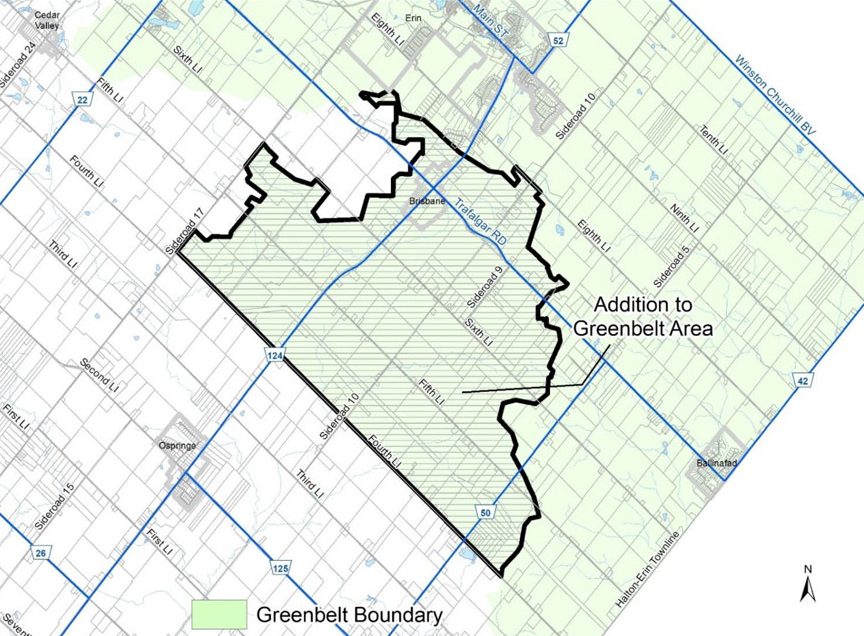GUELPH – The County of Wellington has officially requested over 7,000 acres of land in the Town of Erin that was added to the Greenbelt last year be removed from the provincially protected area.
On Dec. 16, 2022, the province made changes to the Greenbelt Plan boundary, through an Order-in-Council, which removed 15 parcels of land totalling 7,400 acres for development.
At the same time 9,400 acres of land were added to the Greenbelt, including about 7,100 in Erin.
The Erin Greenbelt expansion was incorporated into the Wellington County Official Plan on April 11 through unilateral provincial modifications to the county’s Official Plan Amendment 119.
The amendment also added more than 1,000 acres of mostly agricultural land to urban boundaries in Centre Wellington, Guelph/Eramosa and Minto.
The province has since introduced legislation reversing urban boundary expansions in Wellington County and numerous other municipalities around the province and undoing changes that took land around the GTA out of the Greenbelt.
However, the provisions expanding the Greenbelt area in Erin were left in place.
On Oct. 16 Bill 136 – Greenbelt Statue Law Amendment Act, 2023, was tabled in the provincial legislature.
“The proposed legislation, if approved, would make changes to several pieces of legislation with the primary goal of reversing the decision made by the province to remove 15 parcels of land from the Greenbelt for development purposes,” explained Wellington County manager of planning and policy Sarah Wilhelm in a report to the county’s planning committee.
“The legislation also looks to strengthen immunity provisions across three different statutes to insulate the government from any potential legal actions resulting from decisions on the Greenbelt.”
The report points out the Erin lands added to the Greenbelt are now subject to numerous restrictions including:
- a 40-hectare minimum lot size:
- a requirement surplus farm residence severances be allowed only for residences that existed prior to 2004;
- a prohibition on second residential units;
- a ban on hamlet expansion and redesignation of prime agricultural land to non-agricultural uses; and
- additional restrictions on urban boundary expansion within the protected area.
“Our concern with the proposed legislation is that it does not fully reverse the province’s decision related to Greenbelt boundary changes in December 2022, particularly related to the expansion of the Greenbelt Plan boundary further in the Town of Erin,” Wilhelm notes in the report.
“According to the government’s own statement, the process related to the 2022 changes to the Greenbelt boundary was too fast, not transparent and not supported by [Ontarians]. In our view, these comments apply equally to the expansion area into the County of Wellington.
“The basis for this expansion was to offset lands removed from the Greenbelt boundary. With the Greenbelt lands being restored, the basis for the expansion area is unclear and undermines the province’s position of creating a more transparent process for changes to the Greenbelt.”
The report states county planning staff maintain there is “no technical rationale” for the expansion of the Greenbelt further into Wellington County and they recommend the county ask for the lands to be removed as part of the Bill 136 legislative process.
The report also indicates staff are supportive of the reinstatement of the original Greenbelt Plan areas that were removed from the plan in 2022.
“The county’s position is that we have protections in place that are sufficient for our natural heritage features … so we weren’t supportive of the arbitrary greenbelts expansion that affected our member municipality of Erin,” planning committee chair councillor James Seeley told county councillors on Nov. 30.
Council approved a planning committee recommendation that the staff report be filed in response to a Ministry of Municipal Affairs and Housing request for input on proposed legislation to return lands to the Greenbelt.
Boundary expansion
Following the reversal on Official Plan changes, the province announced exceptions to the urban boundary reversals would be considered where “construction has begun” or where doing so “would contravene existing provincial legislation and regulation.
The province also invited comment from municipalities on those exceptions until Dec. 7.
In a separate report to the county’s planning committee, Wilhelm noted no development applications have been filed and no planning approvals have been issued for most of the properties urbanized by the province through OPA 119.
However, a severance application has been filed, but no planning approval obtained, for the affected property in the Clifford area.
In November the Town of Minto asked the government to leave the expanded Clifford boundary in place, noting the village has the servicing capacity for the additional lands and a developer intending to promptly develop them.
Council approved a planning committee recommendation that:
- the report be received for information and circulated to area municipalities to assist with their response to the ministry; and
- county staff work with the province to recover municipal costs related to implementing and undoing the changes.
Centre Wellington Mayor Shawn Watters said he believes the reversals are a positive change and he thanked staff or their work on the file.
“Obviously we’ll have the opportunity to look at these things in a more fulsome, more thought provoking, way,” he stated.
Councillor Chris White said, “Nowadays, with staff getting new stuff every day, it’s complicated. There’s politics, there’s all kinds of different things involved in it.
“They were very professional, very quick, very responsive, very understanding and they brought forward a great report quick enough for us to meet what was quite a quick deadline for the province.”




